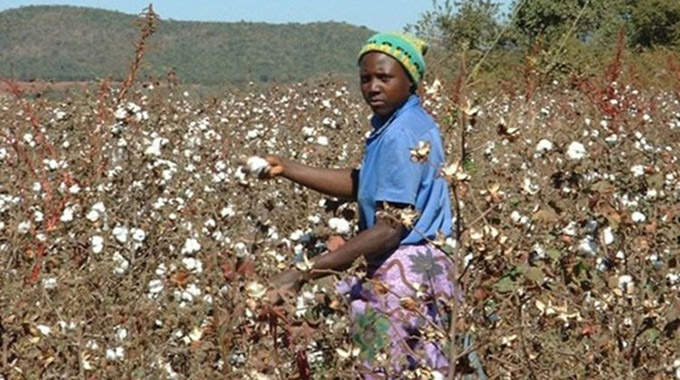Shot in the arm for cotton farmers

Martin Kadzere Senior Business Reporter
Government has expanded a support programme for cotton farmers and will provide inputs worth $60 million during the forthcoming season.
Through the state-owned Cotton Company of Zimbabwe (Cottco), the Government has so far supported small-scale farmers with inputs worth $130 million over the past three years with output nearly increasing threefold to 74 000 tonnes last year from 28 000 tonnes in 2015.
At peak, Zimbabwe produced 351 000 tonnes cotton in 2012, but output gradually fell as farmers shunned cotton production due to low prices and poor support. Production is expected to surpass 100 000 tonnes this year, according to initial Government estimates.
“The level of support will be at the same as last year,” the governor of the Reserve Bank of Zimbabwe Dr John Mangudya told Business Herald in an interview this week.
Cotton is an important cash crop for about 400 000 families in Zimbabwe’s rural areas and used to be one of the country’s largest foreign currency earners.
Side-marketing menace
Cotton farmers are 100 percent financed through contract farming as they lack the means to access funding from banks. Consequently, the size of the cotton crop is a function of contractors’ appetite for risk relative to the returns that they expect.
Cottco pre-finances purchases by providing farmers with seeds, fertilisers and chemical on the agreement that they sell their harvest to the company. But sometimes the terms of the contract are violated through illegal sales to other companies.
Private cotton merchants are enticing farmers to sell to them by offering higher prices than the Government producer price as they would have invested little in production.
The private firms have also taken advantage of the prevailing cash shortages and are luring farmers with hard cash as opposed to mobile payments methods used by Cottco.
While the central bank has stipulated $40 as maximum cash paid for each cotton bale, sometimes the merchants find it difficult to get the money from their banks.
“Private cotton companies do what we call cosmetic financing to warrant their presence during marketing season,” secretary for the Cotton Producer Association Stewart Mubonderi said.
“They then come, offering higher prices and naturally farmers are enticed and use illegal means to dispose of their crop to them.”
Regulatory flaws
Zimbabwe cotton industry was viable until the early 2000s when it was opened up to a multitude of small companies, which wreaked havoc in the sector by inducing side-marketing.
This created challenges with debt recovery, low yield as well as poor operational efficiencies.
The Agriculture and Marketing Authority (AMA), a regulatory board charged to ensure orderly marketing of cotton, has been blamed for failing to promote orderly marketing of the crop.
Even when presented with evidence of illegal methods used by private companies to buy the crop, the regulator had been reluctant to act,” said Mr Mubonderi.
He said while there was a robust legal framework that provides adequate protection for investment by all players, it was not been effectively implemented.
The current uneven playing field where some merchants finance inputs while others simply harvest was a recipe for disaster.
Due to sustained losses, some cotton financiers in the sector have either pulled out of the sector while others have scaled back on their inputs funding to the detriment of grower yield realisation.
Self-fuelling effect
Currently, the locally processed cotton is consumed by local companies while 80 percent is exported.
Industry players said providing adequate support to all segments in the cotton supply chain – from seed production, to cotton growing, to gins to separate seeds and fiber, spinning mills to garment factories – will yield more benefits.
“Supporting all segments is the right approach that has a self-fuelling effect,” said Edwin Chimanye, a Harare textile engineer. “Every improvement causes multiple improvement.”
Zimbabwe’s textile sector used to be one of the country’s major employers, providing jobs to about 51 000 people at its peak. By 2005 employment levels had reduced to 28 822 with 22 178 job losses recorded.
Considering the clothing sub-sector alone, employment numbers sharply reduced from 13 500 in 2009 to 12 506 in 2010, then to 8 627 in 2011 and to a mere 4 748 in 2012, highlights a report by Zeparu.
Job losses in the clothing industry between 2009 and 2012 totalled 8 752, or 65 percent after dollarisation. The textile industry fared even worse than the clothing industry during the same period with such giants as David Whitehead, once the sector’s largest firm, Cone Textiles or Modzone, Merlin and Cotton Printers all collapsing.
“The entire cotton value chain is labour intensive and you can start adding employment numbers by stimulating the whole cotton value chain,” said Mr Chimanye.
Analysts noted that Zimbabwe has major competitive advantages over other textile manufacturing countries.
These include proximity to the industry’s primary raw material cotton in addition to skilled labour and a highly literate population.










Comments